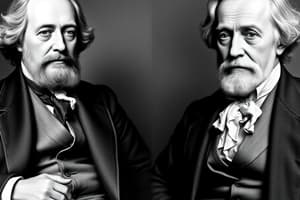Podcast
Questions and Answers
What is the primary focus of Keynesian economic theory?
What is the primary focus of Keynesian economic theory?
- Regulating the money supply
- Tax incentives for businesses
- Self-adjusting market dynamics
- Creating demand through government spending (correct)
Which function is NOT associated with the Federal Reserve?
Which function is NOT associated with the Federal Reserve?
- Supervising and regulating banks
- Managing currency
- Maintaining financial stability
- Controlling fiscal policy (correct)
What type of economic policy does protectionism refer to?
What type of economic policy does protectionism refer to?
- Promoting free trade agreements
- Shielding domestic industries through import taxes (correct)
- Encouraging exports through subsidies
- Reducing tariffs on foreign goods
What was the primary consequence of the Smoot-Hawley Act?
What was the primary consequence of the Smoot-Hawley Act?
Which country is identified as the United States' largest trading partner?
Which country is identified as the United States' largest trading partner?
What does 'comparative advantage' imply?
What does 'comparative advantage' imply?
What does the term 'race-to-the-bottom' signify in international trade?
What does the term 'race-to-the-bottom' signify in international trade?
Which of the following statements is true regarding the United States' trade policy?
Which of the following statements is true regarding the United States' trade policy?
Which economic theory primarily emphasizes the self-adjusting nature of the economy?
Which economic theory primarily emphasizes the self-adjusting nature of the economy?
What is one of the key roles of the Federal Reserve in the financial system?
What is one of the key roles of the Federal Reserve in the financial system?
Which of the following best describes protectionism?
Which of the following best describes protectionism?
The Smoot-Hawley Act primarily led to what action?
The Smoot-Hawley Act primarily led to what action?
Which option correctly identifies one benefit of greater international trade for the United States?
Which option correctly identifies one benefit of greater international trade for the United States?
What characterizes the race-to-the-bottom phenomenon?
What characterizes the race-to-the-bottom phenomenon?
What does NAFTA stand for, and what was its main purpose?
What does NAFTA stand for, and what was its main purpose?
Which person is recognized as the father of modern economics?
Which person is recognized as the father of modern economics?
Flashcards
Keynesian economic theory
Keynesian economic theory
Economic theory that argues government spending can stimulate demand and boost the economy.
Supply-side economics
Supply-side economics
Economic theory that argues tax incentives, spending cuts, and deregulation encourage economic growth.
Protectionism
Protectionism
Government policies that protect domestic industries by taxing imports.
Smoot-Hawley Act
Smoot-Hawley Act
Signup and view all the flashcards
Comparative advantage
Comparative advantage
Signup and view all the flashcards
Federal Reserve
Federal Reserve
Signup and view all the flashcards
Battleground states
Battleground states
Signup and view all the flashcards
WTO
WTO
Signup and view all the flashcards
Classical Economics
Classical Economics
Signup and view all the flashcards
Keynesian Economics
Keynesian Economics
Signup and view all the flashcards
Monetary Economics
Monetary Economics
Signup and view all the flashcards
What are some of the main functions of the Federal Reserve?
What are some of the main functions of the Federal Reserve?
Signup and view all the flashcards
Who is Adam Smith?
Who is Adam Smith?
Signup and view all the flashcards
What is protectionism?
What is protectionism?
Signup and view all the flashcards
What is comparative advantage?
What is comparative advantage?
Signup and view all the flashcards
Study Notes
Economic Theories
- Classical Economics: Self-adjusting economy, market forces resolve issues.
- Keynesian Economics: Government intervention to stimulate demand through spending.
- Supply-Side Economics: Tax cuts and incentives to stimulate supply, reduced government spending.
- Monetary Economics: Regulating the money supply to influence the economy.
Federal Reserve Functions
- Controlling monetary policy (interest rates, money supply).
- Supervising and regulating banks.
- Maintaining financial stability.
- Managing currency.
Key Economic Figures
- Adam Smith: Considered the father of modern economics.
- Jerome Powell: Current Chairman of the Federal Reserve.
Trade Policy
- Protectionism: Shielding domestic industries by taxing imports.
- Protectionist Policies in the US: Followed in the 19th century.
- Smoot-Hawley Act: Increased import duties, including agricultural imports.
- Largest US Trading Partner: Mexico.
- Comparative Advantage: Devoting resources to produce goods and services more efficiently (beneficial for exporters and consumers).
- Disadvantage of International Trade: Job losses in some sectors. Workers are disadvantaged.
- US Trade Strategy: Three-pronged approach—global tariff reductions, regional integration, and bilateral agreements.
- Benefits of International Trade: Trade imbalances reflected in investment, increased national income.
- Disadvantages of International Trade: Job losses, risk of "race to the bottom" (lowering labor standards). Race to the bottom means going from rich countries working to poor countries.
- WTO: World Trade Organization, overseeing trade rules between nations.
- NAFTA: North American Free Trade Agreement, eliminated trade barriers between the US, Canada, and Mexico.
- TPP: The United States is not a part of the Trans-Pacific Partnership.
Recent Election Results
- Battleground States: Arizona, Michigan, North Carolina, Wisconsin, Georgia, Nevada, Pennsylvania.
- Senate Control: Democrats.
- House Control: Republicans.
- Texas Senate Winner: Ted Cruz.
Studying That Suits You
Use AI to generate personalized quizzes and flashcards to suit your learning preferences.




